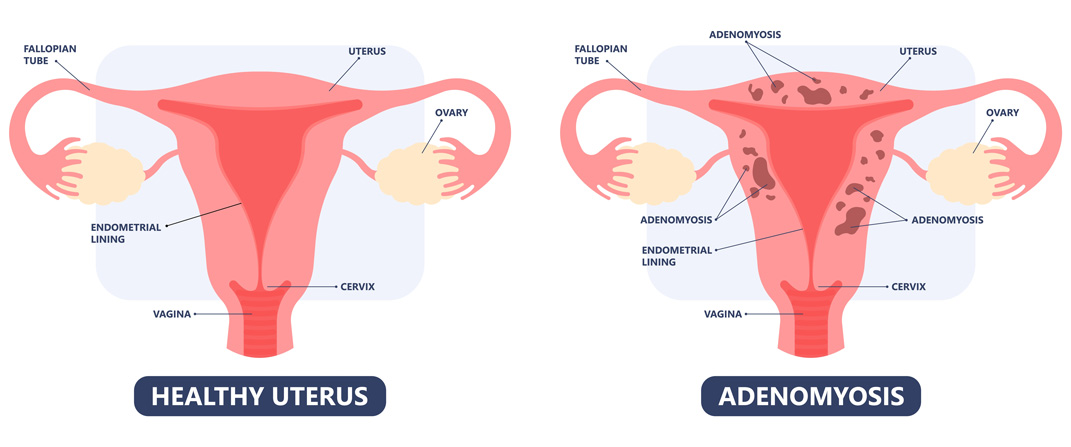Adenomyoma
Adenomyoma of the uterus is a localized nodular aggregate of benign endometrial glands surrounded by endometrial stroma and bordered by smooth muscle. It could be in the myometrium, or it could involve or originate in the endometrium and grow as a polyp.This disease can cause a slightly enlarged uterus. During each menstrual cycle, this tissue thickens, breaks down, and bleeds, resulting in painful periods and severe bleeding.

Adenomyoma can be difficult to diagnose, and symptoms such as severe bleeding and pelvic pain are frequently disregarded if not seen by a specialist. While adenomyoma is neither malignant or precancerous, it can cause terrible discomfort and heavy menstrual bleeding in certain women. Adenomyoma can be diagnosed with an MRI scan and, in some cases, a transvaginal ultrasound, but it is only confirmed after surgery by pathology. Adenomyoma is a very common illness, although it is not usually easily diagnosed by many doctors because initial uterine imaging is often done with an ultrasound which fails to detect it.
Adenomyoma can vary considerably amongst women. It might be localised (limited to a single part of the uterus), diffuse (affecting wide portions of the uterine muscle), scattered, or clustered. Adenomyoma can cause significant menstrual bleeding and agonising discomfort in some women; however, up to 30% of women with adenomyoma show no symptoms at all.
Symptoms of adenomyoma:
Menstrual cycle causes severe pelvic pain
Leg and back discomfort
Bloating and abdominal pain
The pressure in the pelvis
Abdominal swollenness
Clots in the legs and pelvic region
Cramps during menstruation
Pelvic discomfort
Causes of Adenomyoma
The causes of adenomyoma are unknown; nevertheless, certain theories about its genesis have emerged. According to one idea, endometrial cells can migrate and infiltrate the normal uterine wall. Another notion is that endometrial cells arise from cells in the uterine wall.
Diagnosis of Adenomyoma
The best imaging exam for identifying adenomyoma is an MRI scan. An MRI shows a swollen junctional zone, which is the thin innermost layer of the uterine muscle wall. On imaging investigations, adenomyoma can form a mass and be misdiagnosed as fibroids. Although less sensitive than an MRI, ultrasonography can be used to detect adenomyoma. Sonographic findings of adenomyoma include a larger “globular” uterus, thicker endometrial lining, and a heterogeneous uterine wall. If your ultrasound is normal and you suspect adenomyoma, you should get an MRI.Examining the cervix- It is possible to diagnose that the uterus is enlarged.
Sonohysterography- During this method, a saline solution is injected into the uterus using a small catheter.
Biopsy of the endometrium-The collection of uterine tissue in order to determine whether or not uterine bleeding is caused by adenomyoma.
Adenomyoma should always be considered in people who experience copious bleeding and significant pelvic pain during their periods. Patients with this illness may suffer for years due to the fact that it is more frequent than most gynecologists recognise. Adenomyoma should be suspected in these cases, and clinical and diagnostic testing should be conducted to confirm or rule out adenomyoma.
Treatment for Adenomyoma
Anti-inflammatory medications: To relieve discomfort, your doctor may prescribe anti-inflammatory drugs. You can reduce menstrual blood flow and relieve pain by starting an anti-inflammatory medication one to two days before your period begins and continuing to take it during your period.
Hormone replacement therapy: Birth control tablets that contain both oestrogen and progestin, may help to reduce the severe bleeding and pain associated with adenomyosis.
Hysterectomy is the main treatment for adenomyoma. Unlike fibroids, which are frequently enclosed by a capsule, adenomyotic tissue and normal uterine tissue do not have a defined border. As a result, adenomyoma cannot be efficiently removed in the same way as fibroids can, and when removed, sections of the uterine muscle are also removed.
For any other query or second opinion book your appointment with DR.ANSHUMALA SHUKLA one of the top gynecologists at Kokilaben Dhirubhai Ambani hospital, Andheri.
